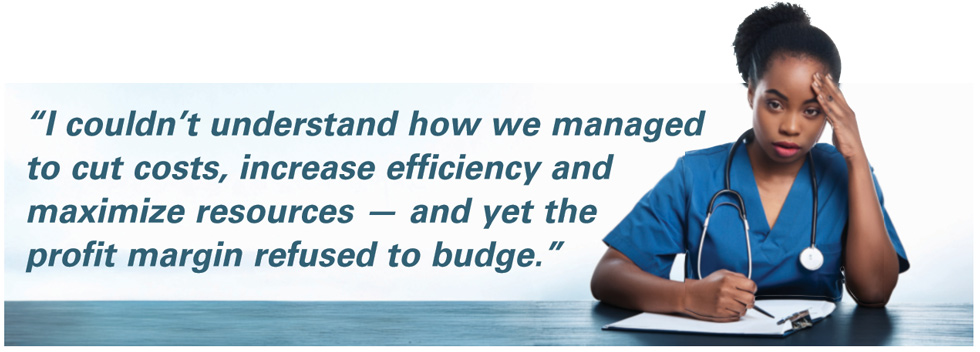- Home
- Article
Software Solutions: The Case for Outsourcing Revenue Management
By: Jeanine Watson, MSN, RN, CNOR(E), CASC
Published: 6/26/2025
Manually juggling multiple functions is just asking for trouble.
In my former role as a senior leader of an ASC, I entered a finance meeting eager to share our process improvement initiatives that had resulted in reductions in expenses. Normally I dreaded finance meetings, but this time I was excited to highlight our work, which had cut our costs and saved us money.
You can imagine my surprise when the meeting went in a different direction. Not only was the news not good — it was bad! There was no doubt we made huge strides in reducing expenses, but it wasn’t enough to impact the bottom line, which was well below projections based on actual volume. I was charged with identifying the factors contributing to the low profit margin and creating a plan to correct it.
‘I don’t get it?’
I couldn’t understand how we managed to cut costs, increase efficiency and maximize resources — and yet the profit margin refused to budge. I was at my wit’s end. Before I could create a plan of attack, I needed to understand the big picture.
Since operational efficiencies, elimination of waste and supply chain safeguards contributed to significant cost savings, I knew I was missing something. I also knew that expenses were only half the equation, so I decided to take a deep dive into our revenue cycle management (RCM) processes.
I was new to my role of running ASCs within a large hospital system and I wasn’t sure where to start, so I started making connections.
I discovered insurance authorization, billing, coding and accounts receivable were managed by several departments, all in different locations and all reporting to different leaders. This was an eye-opener, but not the only surprise. These were the same departments that supported the hospital, and they were all new to ASC billing. This made the complex task even more difficult, as the practices that work in hospitals do not necessarily transfer to ASCs, which often have smaller profit margins, different payor contracts and must adhere to specific coding practices to maximize reimbursement.
During our deep dive, we identified gaps in every step of the revenue cycle. It was clear that our manual processes, outdated technology and inadequate training were key contributors to our poor financial performance. Making minor improvements in these areas would not solve our problem, so we invested in RCM software and included process leaders in each step. We successfully increased the efficiency of filing claims, decreased the times of billing cycles and reduced the number of claims that got denied.
I would love to take credit for the success, but the truth is the software made all the difference. We were able to generate reports, automate tasks, create safeguards with notifications and communicate across teams more effectively.
An RCM deep dive
Revenue cycle management refers to the entire financial process of managing claims, payments and revenue generation from patient services. Steps in the revenue cycle include pre-registration, registration, charge capture, coding, claims submission, payment posting, denial management, patient collections and reporting. It is a complex process and a single error or delay in one of the steps impacts the entire process.
There is also a sense of urgency in the form of filing and appeal deadlines that make timing critical and delays costly. Remember, every day revenue is tied up in the process, it isn’t working for you by accruing interest, covering expenses or reinvesting in the company.
Each step in the revenue cycle can be managed by different people or departments, and small centers may opt for a single person to manage the entire process. Common challenges related to manual processes include data entry errors, delays in pre-authorizations, coding inaccuracies, denials, underpayments and payment collection difficulties. To understand the big picture of your RCM processes, you should be familiar with key performance indicators such as days in accounts receivable, denial rates and collection rates. Evaluating this data can provide insight into the areas delaying your process and possibly contributing to your revenue shortfalls.
Although many ASCs still use paper medical records, more are opting to spring for electronic scheduling systems that incorporate RCM software. If your center is managing your revenue cycle through manual processes, you may want to consider the advantages of implementing software or using a revenue cycle organization.

Here are several of the benefits that RCM software provides:
Increased efficiency and automation. Automating repetitive tasks such as eligibility checks, claim submissions and payment posting reduces manual data entry and administrative workload, speeding up the entire billing process. Improved accuracy. Built-in validation tools minimize errors in coding, billing and claims, reducing claim denials and rework by flagging issues before submission.
Faster reimbursement. Electronic submissions and real-time tracking shortens the time between service delivery and payment.
Enhanced denial management. Identifying trends in denials helps staff correct and submit claims quickly by using tools for appeals and follow up, increasing recovery of lost revenue.
Improved patient experience. Patients have access to online portals to view bills, make payments and communicate with billing staff, increasing their overall satisfaction and avoiding delays in scheduling.
Real-time analytics and reporting. Dashboards and reports provide visibility into key performance indicators that provide leaders with the ability to make data-driven decisions that can improve financial performance.
Compliance and security. Programs ensure adherence to HIPAA and other regulatory requirements while tracking audit trails and maintaining secure access to sensitive financial data.
Scalability and integration. Electronic health record integration and practice management systems can be scaled with the growth of the ASC, supporting multiple specialties and locations.
The Association for periOperative Registered Nurses’ (AORN’s) ASC Academy: Administrator Essentials training program can help new ASC administrators navigate the nuances of managing revenue cycles and other daily challenges. Learn more at www.aorn.us/ascadmincourse. OSM
.svg?sfvrsn=be606e78_3)
.svg?sfvrsn=56b2f850_5)